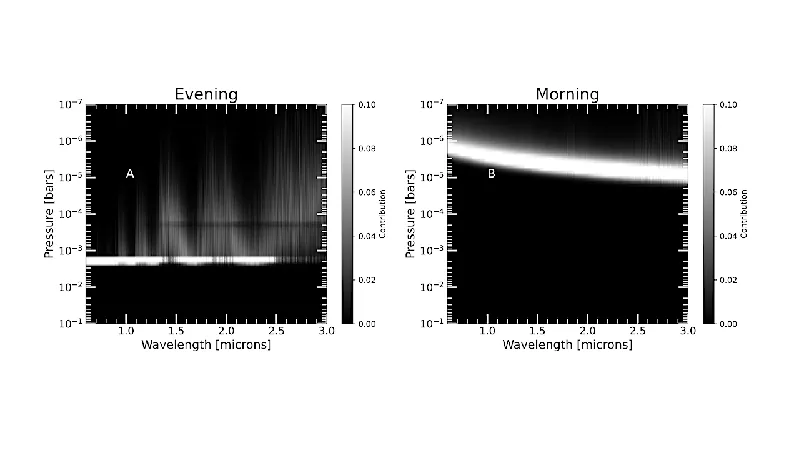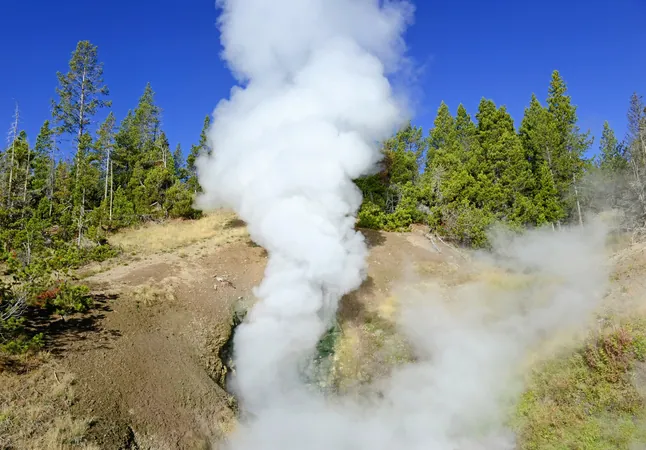
Mysteries Unveiled: The Weather Secrets of Exoplanet WASP-94A b
2025-05-19
Author: Rajesh
A Glimpse into WASP-94A b's Atmosphere
Exoplanets are full of surprises, and WASP-94A b is no exception! Recent studies have shed light on the atmospheric conditions of this intriguing gas giant, revealing a captivating contrast in weather patterns that might change our understanding of distant worlds.
Morning Clouds vs. Evening Clarity
Astronomers have detected significant limb asymmetry in the planet’s transmission spectrum, indicating that while the morning limb is cloaked in clouds, the evening limb basks in clarity. This revelation showcases a cooler morning atmosphere contrasted by a hotter evening, where water vapor absorption is notably strong.
How Are These Clouds Formed?
The formation processes of aerosols remain a puzzle in the realm of exoplanet research. However, findings suggest that cloud droplets form at low pressures in the morning and are propelled upwards due to vigorous vertical dynamics. As these droplets make their way to the hotter evening limb, they begin to evaporate, necessitating a substantial temperature difference to facilitate this transition.
What This Means for Future Research
This discovery emphasizes that the clouds on gas giants like WASP-94A b can cycle dramatically between day and night sides, contradicting previous assumptions about static photochemical hazes. Ignoring such atmospheric dynamics could severely misrepresent the chemical compositions of these planets. As we rethink a decade of data collected from the Hubble Space Telescope, it's becoming clear that limb-resolved spectroscopy is vital in understanding the atmospheric makeup of both gas giants and terrestrial exoplanets.
Visual Insights
To illustrate these findings, researchers have produced detailed maps and spectra of the planet’s evening and morning limbs. These visuals reveal how cloud scattering shapes the observable spectrum, highlighting atmospheric components such as water vapor and clouds.
The Future of Exoplanet Exploration
As technology evolves, so will our methods for exploring and understanding these distant worlds. The complexities of WASP-94A b’s atmosphere are just the tip of the iceberg, hinting at deeper mysteries yet to be uncovered as scientists continue to push the frontiers of exoplanet research.




 Brasil (PT)
Brasil (PT)
 Canada (EN)
Canada (EN)
 Chile (ES)
Chile (ES)
 Česko (CS)
Česko (CS)
 대한민국 (KO)
대한민국 (KO)
 España (ES)
España (ES)
 France (FR)
France (FR)
 Hong Kong (EN)
Hong Kong (EN)
 Italia (IT)
Italia (IT)
 日本 (JA)
日本 (JA)
 Magyarország (HU)
Magyarország (HU)
 Norge (NO)
Norge (NO)
 Polska (PL)
Polska (PL)
 Schweiz (DE)
Schweiz (DE)
 Singapore (EN)
Singapore (EN)
 Sverige (SV)
Sverige (SV)
 Suomi (FI)
Suomi (FI)
 Türkiye (TR)
Türkiye (TR)
 الإمارات العربية المتحدة (AR)
الإمارات العربية المتحدة (AR)